|
| *****SWAAG_ID***** | 431 |
| Date Entered | 19/01/2012 |
| Updated on | 23/01/2012 |
| Recorded by | Tim Laurie |
| Category | Geological Record |
| Record Type | Geological HER |
| SWAAG Site Name | |
| Site Type | |
| Site Name | |
| Site Description | |
| Site Access | Army Range |
| Record Date | 15/01/2012 |
| Location | Bellerby Moor MOD Ranges. Moorland SSSI. |
| Civil Parish | Bellerby |
| Brit. National Grid | SE 08476 93260 |
| Altitude | 311m |
| Geology | Calcareous spring line in faulted Namurian strata above the Main Limestone. BGS Sheet 41 Richmond refers. |
| Record Name | Tufa mound at abandoned spring in Pine Plantation. |
| Record Description | This small tufa spring mound survives to a height of approximately 1.0m. It is capped with turf and heavily eroded but otherwise relatively undisturbed.The stratigraphy of deposition can be seen in the exposed face of the tufa. This one of several tufa springs (each to be recorded seperately) at this locality and is soon to be demolished as it is within the footprint of a new small arms range |
| Dimensions | See photographs |
| Geographical area | |
| Species | |
| Scientific Name | |
| Common / Notable Species | |
| Tree and / or Stem Girth | |
| Tree: Position / Form / Status | |
| Tree Site ID | 0 |
| Associated Site SWAAG ID | 0 |
| Additional Notes | The following Notes on Tufa have been provided by John Russell:
The photograph shows a tufa mound around the site of a former spring. Tufa is an outdoor variety of a stalagmite and these are secondary deposits.
Tufa is a spongy, soft, porous sedimentary rock which exhibits a wide range of colours. It forms mainly where there are springs and water seeps. It may form, on rare occasions, in river and lakes. Tufa is a soft carbonate of lime which may envelope animals and plants as it grows. Tufa may have a netted or reticulate structure and be quite friable.
Travertine is another form of limestone with the same origin as tufa. It is denser and often banded. It may also be known as drip stone or flow stone. Slowly dripping water in caverns is responsible for stalagmites, stalactites and columns.
The following notes on Tufa have been provided by John Russell:
Tufa, travertine, flow stone, drip stone and stalagmite (et al)are the result of acid water dissolving limestone and re-depositing it. The acid water is formed in two ways. It can be created by raindrops picking up carbon dioxide as the droplet falls through the air. The rain water is converted into a very weak carbonic acid. The water also becomes more acidic as it runs off the moors through acidic peat bogs. The acids dissolve the limestone and carry it away as calcium bicarbonate. As the calcium bicarbonate rich water becomes exposed to the air it begins to evaporate. The calcium bicarbonate loses carbon dioxide and is deposited as calcium carbonate.
Springs and water seep form mounds of tufa which can be several feet high. The tufa mound in the photograph is no longer active as the water table has moved. These deposits are seldom very large and most appear restricted in time to the Quaternary Period. Most of the deposits are on the Millstone Grits high on the moors over the Swale and Wensleydale valleys.
Studies of this group of rocks yield useful information about paleoclimates. Deposition only takes place when water is flowing, so if water is locked up by a drop in temperature there is little deposition. Ice Ages are detected and dated using these rocks.
Tufa can be found in other locations including Mother Shipton’s Cave and Dropping Well in Knaresborough, Janet’s Foss at Goredale Scar and How Edge Scars, Whitsundale.
|
| Image 1 ID | 2096 Click image to enlarge |
| Image 1 Description | Bellerby Moor. Deeer Park Plantation. Tufa Mound at abandoned Spring Rise. The spring now rises a few metres to the west. | 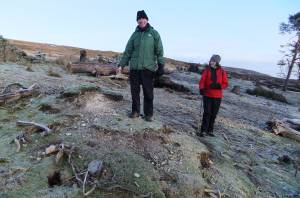 |
| Image 2 ID | 2097 Click image to enlarge |
| Image 2 Description | Bellerby Moor. Area with calcareous, tufa forming springs. On footprint of New Small Arms Range | 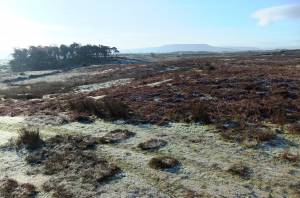 |
| Image 3 ID | 2098 Click image to enlarge |
| Image 3 Description | Bellerby Moor. Army Range. Tufa spring mound in Deer Park Plantation. | 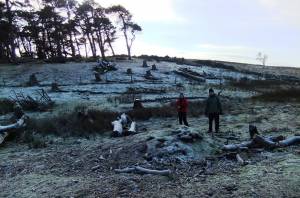 |
| Image 4 ID | 2129 Click image to enlarge |
| Image 4 Description | Tufa. Detail. Photo John Russell. | 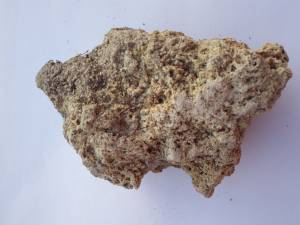 |
| Image 5 ID | 2130 Click image to enlarge |
| Image 5 Description | Tufa. Detail. Photo John Russell. | 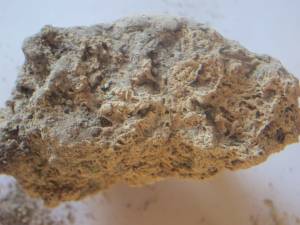 |




